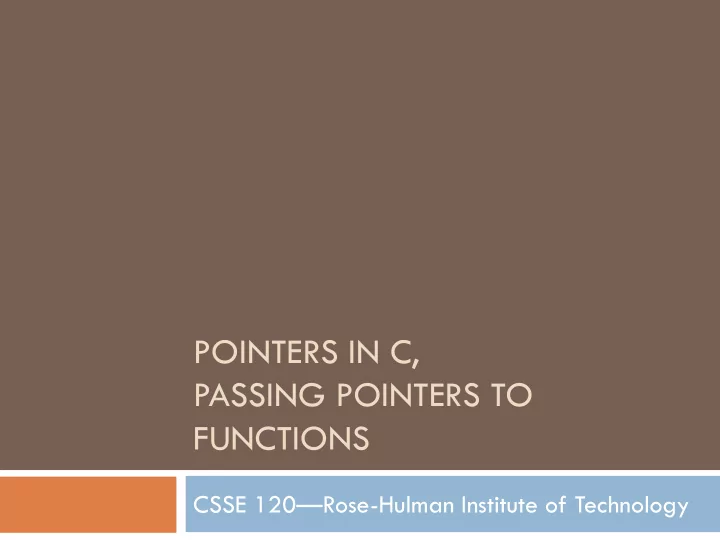

POINTERS IN C, PASSING POINTERS TO FUNCTIONS CSSE 120 — Rose-Hulman Institute of Technology
Parameter Passing Styles Most programming languages offer several means of passing parameters. We have seen pass-by-value, in which the argument is evaluated and a copy of the value is assigned to the formal parameter of the called function. We will now explore a second style
An Analogy Suppose a friend asks you for 5 bucks. You have at least two choices: You reach into your wallet and give your friend 5 1. bucks. You give your wallet to your friend and ask them to 2. take 5 bucks. Most people will use the second method only with true friends.
Evaluation of the Analogy In the second case, the person receiving the wallet may: Take 5 bucks. Take all the money you have. Take no money Put money into your wallet
Passing by pointers - Part 1 We will now introduce you to passing a parameter by pointer. If you think of variables as wallets, then we need to have a way of passing wallets rather than the contents of a wallet. If you prefer to think of variables as sticky notes, then we need to have a way of passing a sticky note rather than what is written on the sticky note.
Passing by pointers - Part 2 We pass a parameter by pointer by adding the ‘&’ symbol in front of the variable name. If you have a variable called x, then you pass it by pointer like so: &x
Passing by Point - Part 3 The called function needs to know that it receives a wallet/sticky note rather than a value. As such, we need to tell it. We do this by adding the symbol ‘*’ in front of the parameter name. If you have a parameter called y, then you change it to: *y
A simple example void foo(int *a){ *a = 7; Receive an address printf("%d\n", *a); } int b = 3; Send the address of b foo(&b); printf("%d\n", b);
A Second Example Consider this C function: void downAndUp(int takeMeHigher, int putMeDown){ takeMeHigher = takeMeHigher + 1; putMeDown = putMeDown - 1; } Given : int up = 5, down = 10; Invoke: downAndUp(up, down); After we return from downAndUp, will the values of up and down be changed? Q1
Second Example - Cont’d How do we modify downAndUp() so that it changes the values of its parameters? Together, implement a function that passes pointers to values to be changed Use project PointersInclass that you already checked out Implement downAndUpthatWorks() Use function testdownAndUpthatWorks() to test downAndUpthatWorks() Q2
Pointers Variables are names of memory addresses. Variables that we have seen so far hold values such as integers, floats, and characters. A pointer is a variable that holds the address of some variable. To continue our analogy, a pointer is a variable that holds a wallet or a sticky note. Q3
Pointers Cont’d We use the ‘*” to indicate that a variable is a pointer. Examples: int *aVariableThatHoldsAPointerToAnInt; int aVariableThatHoldsAnInt = 4; int *pNum; int num = 6;
Assignments to Pointers We need to have a way of obtaining the address of a variable, rather than its contents. We obtain the address of a variable by using the ‘&’ (address) operator. Example continued: int *pNum; int num= 4; pNum = #
Visualizing Pointers Box and Pointer Diagrams int num = 4; int *pNum; pNum = # pNum: num: ??? 4 memory: Both, num and *pNum are 4.
Visualizing Pointers – Part 2 int num = 4; int *pNum; pNum = # double change = 0.45 ; double *pChange; pChange = &change; *pChange = .62; pNum: pChange: num: change: ??? 4 //// 0.62 0.45 . . . memory: Q4-5
Summary of Pointers Example of a pointer variable: *pNum Example of a integer variable: num Assigning a value to an int: num = 4; Obtaining the address of a variable: &num Assigning an address to a pointer variable: pNum = # Assigning a value to the variable that a pointer variable points to: *pNum = 7;
Summary of Pointers What happens, if we do: pNum = 7 instead of: pNum = &num What happens, if we do: *pNum = &num instead of: *pNum = 7
Proof that Pointers are Memory Addresses Try the following code in the PointersInClass project: printf("num = %d and is stored at %p\n", num, &num); printf("pNum = %p and is stored at %p\n", pNum, &pNum); Q6-8
Practice with Pointers int x = 3, y = 5; 1. 2. int *px = &x; 3. int *py = &y; 4. printf("%d %d\n", x, y); 5. *px = 10; 6. printf("%d %d\n", x, y); /* x is changed */ 7. px = py; 8. printf("%d %d\n", x, y); /* x not changed */ 9. *px = 12; 10. printf("%d %d\n", x, y); /* y is changed */
Break Starring Binky ! (See http://cslibrary.stanford.edu/104/)
Pointer Pitfalls Don't try to dereference an unassigned pointer: int *p; *p = 5; /* oops! Program probably dies! */ Pointer variables must be assigned address values. int x = 3; int *p; p = x; /* oops, RHS should be &x */ Be careful how you increment *p += 1; /* is not the same as … */ *p++;
In-class exercise on pointer pitfalls The rest of today’s quiz lets you see some pointer pitfalls in action. These make great exam questions! Do it now When you are done, start the homework: More pointer output Writing functions to change variables doubleMe swap scanf revisited Part 2 Q1 - 4
Recommend
More recommend